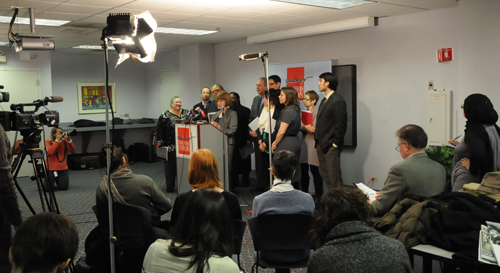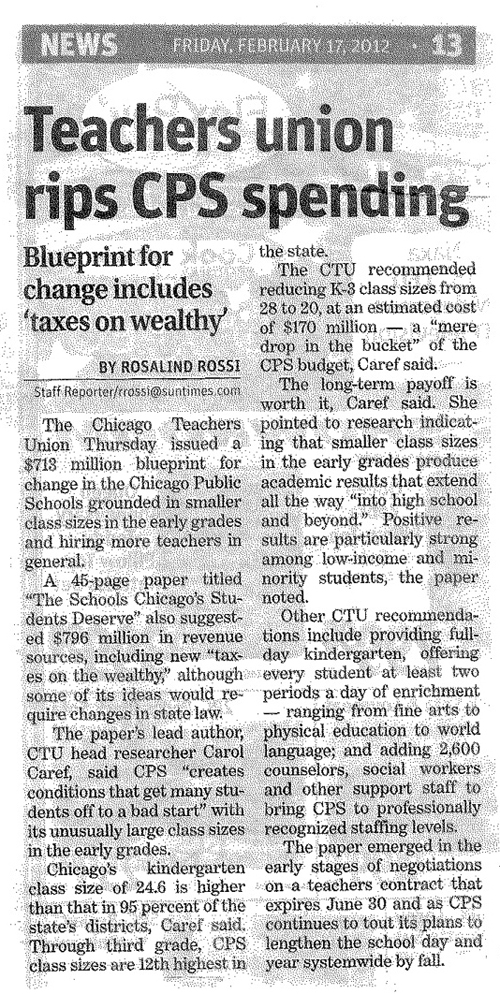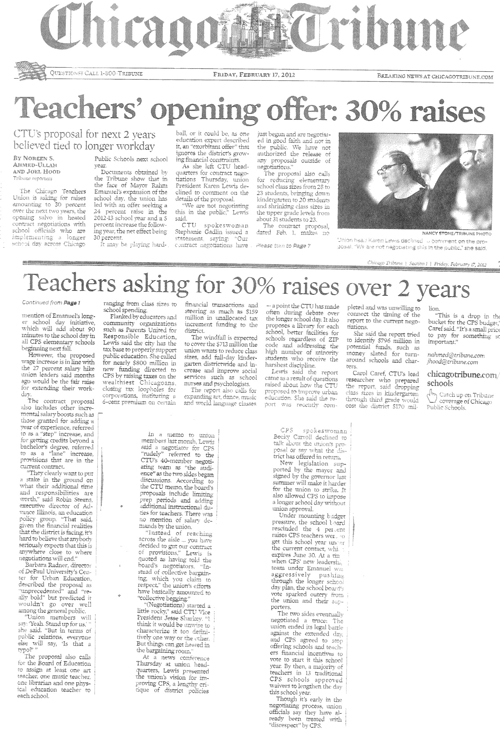CTU Research Director Carol Caref explains origins of 'The Schools Chicago's Students Deserve'
As teachers, we experience on a daily basis both joy and frustration. Joy from our students and knowing the important role we play in their lives; frustration because our students deserve so much more from their education. As a union, it is our responsibility to assert leadership on educational issues, to familiarize ourselves with the research, and offer practical solutions. That is the goal of this report.
 Chicago Teachers Union Research Director Carol Caref (above at podium) presented the description of how the CTU researchers developed the 45-page CTU report, "The Schools Chicago's Students Deserve" at the well-attended February 16, 2012 press conference at CTU headquarters. Substance photo by George N. Schmidt.One thing we know is that the policies of the past 20 years, both locally and nationally, have not solved the problem of inequities between the education received by Chicago public school students and their peers in wealthy suburban or private schools.
Chicago Teachers Union Research Director Carol Caref (above at podium) presented the description of how the CTU researchers developed the 45-page CTU report, "The Schools Chicago's Students Deserve" at the well-attended February 16, 2012 press conference at CTU headquarters. Substance photo by George N. Schmidt.One thing we know is that the policies of the past 20 years, both locally and nationally, have not solved the problem of inequities between the education received by Chicago public school students and their peers in wealthy suburban or private schools.
One obvious reason is inequitable funding. Illinois is among the bottom three states when it comes to fairness in funding for education. Illinois school funding comes mostly through local property taxes, so communities with concentrated poverty receive fewer school funding dollars. Research from the Education Law Center shows that despite having the fifth largest state economy in the U.S., Illinois ranks 33rd in the country for percent of state Gross Domestic Product spent on public education.
Furthermore, according to the Center for American Progress, in Illinois, African American and Latino students receive little more than 90% of the per pupil expenditure received by white students.
The paper outlines solutions to these funding inequities, including asking corporations to pay their fair share for the education of those who may work in their companies or buy their products. It calls on the city to take back unallocated TIF funds and use the money for services including the schools. It calls for revamping school funding structures to provide comparable funding for both high and low poverty districts, as has been done in New Jersey.
What can re-prioritization of funding do for Chicago’s students?
 Chicago Teachers Union President Karen Lewis (above at podium) took more than a dozen questions from corporate reporters, who then proceeded to ignore the majority of findings in the CTU report and focus on a couple of small aspects to the situation. Substance photo by George N. Schmidt.First of all it can buy smaller class sizes. The groundbreaking 1999 Tennessee STAR Project showed that randomly putting students into small classes of 13 to 17 instead of the normal classes of 22 to 25, led not only to academic improvements during the time students were in the small classes, from kindergarten to third grade, but also that those improved academic results continued into high school and beyond.
Chicago Teachers Union President Karen Lewis (above at podium) took more than a dozen questions from corporate reporters, who then proceeded to ignore the majority of findings in the CTU report and focus on a couple of small aspects to the situation. Substance photo by George N. Schmidt.First of all it can buy smaller class sizes. The groundbreaking 1999 Tennessee STAR Project showed that randomly putting students into small classes of 13 to 17 instead of the normal classes of 22 to 25, led not only to academic improvements during the time students were in the small classes, from kindergarten to third grade, but also that those improved academic results continued into high school and beyond.
Because of that study, 32 states and countless school districts created policies requiring small class sizes. But not Illinois and not Chicago. According to statistics from ISBE, the Illinois State Board of Education, Chicago’s kindergarten class size is larger than 95% of the school districts in Illinois. At the early childhood level, Chicago has the 12th highest average class size in Illinois.
At the Kindergarten through third grade level, 28 is supposed to be the maximum class size in Chicago, but many classes start out with more students, sometimes as many as 40. By setting this class size, which CPS is allowed to do without union bargaining, they do a tremendous disservice to young students in their crucial, early years of school. They create the conditions that get many young people off to a bad start in their educational lives. If CPS were to lower class sizes in kindergarten through third grade from 28 to 20, it would cost approximately $170 million. Considering the CPS budget, that seems a small price to pay for something so important.
Professional organizations of social workers, school psychologists, counselors, and school nurses have carefully studied the necessary number of these professionals needed to properly serve students. CPS does not even come close to what is recommended. By looking at the numbers of service professionals employed by CPS and comparing those numbers to the ones recommended, we have found that CPS falls short by about 2500 staff.
However, the actual numbers needed are probably greater, because of the population CPS serves, which is 86% low-income. Every study that compares academic outcomes by income finds that poverty is the number one correlate to low-achievement. For example, at the end of the 2011 school year there were 15,580 homeless students attending CPS schools. If all of the 370 social workers currently employed by CPS only provided services for homeless students, each would have a caseload of 42. This would give social workers just a few hours a month to meet the ongoing needs of each homeless student.
Of course, school social workers provide services for students with homes as well. They work with students who are abused, involved with gangs, neglected, pregnant, or have substance abuse or anger management issues, among other needs. Social workers also are charged with helping students and their families access social services and working closely with special needs students and their families.
Similarly, school nurses, counselors and psychologists play a crucial role in our schools, and should not be understaffed.
 Anyone who had been at the February 16 press conference and read the 45-page CTU report would have asked whether Chicago Sun-Times reporter Roslaind Rossi had bothered to read CPS financial reports before focusing the newspaper's readers on a misrepresentation of CPS finances, instead of on the revolutionary content of "The Schools Chicago's Students Deserve." "Taxes on the wealthy" was a minor aspect of the report and the discussion during the February 16 press conference. Our research also found that in 2012, 58 years since Brown vs. Board of Education was to end segregated schools, close to 70% of African American students in Chicago attend schools that are intensely segregated, meaning greater than 90% of students at the school are African American. One way the inequities represented by this segregation show themselves is in the Autonomous Management and Performance Schools, also known as AMPs. 40% of all the white students in CPS go to an AMPS school. On the other hand, we know from our analysis of CPS data, that the annual “hit lists” of schools that are targeted for disruptive interventions, experimentation and closure are typically composed of 100% students of color living in segregated and economically devastated neighborhoods.
Anyone who had been at the February 16 press conference and read the 45-page CTU report would have asked whether Chicago Sun-Times reporter Roslaind Rossi had bothered to read CPS financial reports before focusing the newspaper's readers on a misrepresentation of CPS finances, instead of on the revolutionary content of "The Schools Chicago's Students Deserve." "Taxes on the wealthy" was a minor aspect of the report and the discussion during the February 16 press conference. Our research also found that in 2012, 58 years since Brown vs. Board of Education was to end segregated schools, close to 70% of African American students in Chicago attend schools that are intensely segregated, meaning greater than 90% of students at the school are African American. One way the inequities represented by this segregation show themselves is in the Autonomous Management and Performance Schools, also known as AMPs. 40% of all the white students in CPS go to an AMPS school. On the other hand, we know from our analysis of CPS data, that the annual “hit lists” of schools that are targeted for disruptive interventions, experimentation and closure are typically composed of 100% students of color living in segregated and economically devastated neighborhoods.
Another indication of issues with racial justice in CPS is the suspension rate, which was the highest of all big-city school districts in 2008, with 13% of students suspended. However these suspensions were not evenly distributed. One out of every four Black male students was suspended. Black males comprised nearly the majority of suspensions despite being only a quarter of the CPS student population, according to information from Catalyst.
The report also addresses the importance of pre-kindergarten and kindergarten access for all children and for students to have access to art, music, world language, and physical education classes on a regular basis. CPS needs to provide appropriate education for special education and emergent bilingual students, to provide quality school facilities, and to partner with parents.
Also, students need teachers who are respected as professionals — paid salaries comparable to others with their education and experience and given time to adequately plan lessons and collaborate with colleagues.
Internationally, teachers in high performing countries have equal amounts of teaching and preparation time in their day. This is also true for the unionized teachers who work at the private University of Chicago Laboratory Schools. In Japan, teachers work together on lessons, observe the teaching of the collaboratively created lesson and discuss those lessons as a regular part of their routine. Teachers in Japan spend less than 40% of their working hours over the school year teaching. CPS students also deserve teachers who are allowed this important preparation time.
 The release of the CTU report "The Schools Chicago's Students Deserve" was not presented as a part of the current contract negotiations between CTU and CPS, but the Chicago Tribune managed to miss most of the content of the 45-page report and present the issues under a screaming headline which anticipates the soon-to-be-released Tribune claim that CPS is to face another huge "deficit" even after CPS financial records show that CPS lied, with the help of the Tribune, about the state of its finances during the final months of the Huberman administration in 2010.Greater than 87% of CPS students are African American or Latino. Yet, a decade of school closings has thinned the ranks of veteran educators of color in CPS. Since 2000, African American teachers have declined from 40% to only 30% of CPS teachers. Despite the uptick in their percentage, Latino teachers are still sorely underrepresented in a school system that now has 44% Latino students. In the schools identified by CPS for closure this year, 65% of teachers are African American.
The release of the CTU report "The Schools Chicago's Students Deserve" was not presented as a part of the current contract negotiations between CTU and CPS, but the Chicago Tribune managed to miss most of the content of the 45-page report and present the issues under a screaming headline which anticipates the soon-to-be-released Tribune claim that CPS is to face another huge "deficit" even after CPS financial records show that CPS lied, with the help of the Tribune, about the state of its finances during the final months of the Huberman administration in 2010.Greater than 87% of CPS students are African American or Latino. Yet, a decade of school closings has thinned the ranks of veteran educators of color in CPS. Since 2000, African American teachers have declined from 40% to only 30% of CPS teachers. Despite the uptick in their percentage, Latino teachers are still sorely underrepresented in a school system that now has 44% Latino students. In the schools identified by CPS for closure this year, 65% of teachers are African American.
In this report, CTU has outlined research-based solutions to move CPS to provide the schooling that all our students deserve. A child’s education should not depend on race or zip code!

